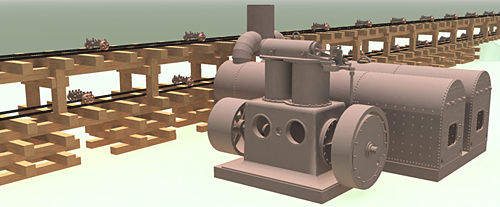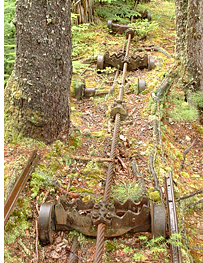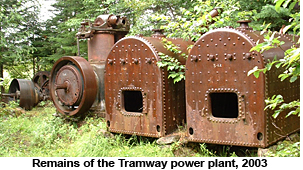DACF Home → Bureaus & Programs → Bureau of Parks and Lands → Discover History & Explore Nature → History & Historic Sites → The Eagle Lake & West Branch Railroad
The Eagle Lake Tramway

This incomplete 3-D model of the tramway power plant on the Chamberlain Lake end shows the Westinghouse compound engine next to the two Hodge boilers that provided the steam pressure to power the engine. Leather belts then ran from the wide wheels on the engine to gears that drove the tramway itself. This whole area, including the adjacent section of wooden cribbing, tracks, and trucks, were enclosed in a large wooden building. Today, only the iron and steel pieces remain at the site. Work on the 3D model and detailed documentation of the tramway continues.
Though it is now just a collection of rusty parts strewn through a remote forest, the Eagle Lake Tramway is one of the most fascinating examples of Maine ingenuity. Devised more than a century ago to transport logs from one lake to another, this steam-powered mechanical system is remarkable testimony to old-fashioned know-how and a willingness to take on any problem.
In the constant struggle to bring timber from Eagle and Churchill Lakes down to Chamberlain Lake and the via the Telos Cut and Webster Lake to the East Branch Penobscot, the first automated mechanical system arrived in the fall of 1902. With the help of steam power, Fred Dow, an engineer for lumber barons H.W. Marsh and F.W. Ayer, constructed a tramway to do the job.
Essentially, the tramway was a small railroad pulled by a six thousand foot cable loop. Steel trucks attached to the cable carried logs across a three thousand foot passage between Eagle and Chamberlain Lakes at the rate of about three miles per hour. As the logs dropped off at the Chamberlain end, each empty truck looped underneath to a lower track and returned to Eagle Lake for another load. The tramway system worked remarkably well for more than six seasons, hauling one hundred million board feet before its use was discontinued.
Most of the tramway parts were boated across Moosehead Lake
during the summer and fall of 1901. That winter, H.N. Bartley
hauled what remained at Greenville, particularly the 6,000
feet of continuous cable.  It
was an exhausting job using horse teams and skids, and by
the time the teams reached Smith’s halfway camp on the
West Branch of the Penobscot, they cut the cable into two
separate sections for easier hauling. When construction was
completed, the Tramway posed two problems. When the system
was fired up and put in gear, workers discovered that none
of the 7/8" bolts that held the 600 trucks and 600 clamps
to the cable were tight enough and the whole system slipped.
This occurred because the threads on each bolt did not reach
far enough down the bolt shaft to tighten the nuts as much
as was necessary. The only way to overcome this problem was
to remove all 4,800 bolts and lengthen the threads with a
hand die.
It
was an exhausting job using horse teams and skids, and by
the time the teams reached Smith’s halfway camp on the
West Branch of the Penobscot, they cut the cable into two
separate sections for easier hauling. When construction was
completed, the Tramway posed two problems. When the system
was fired up and put in gear, workers discovered that none
of the 7/8" bolts that held the 600 trucks and 600 clamps
to the cable were tight enough and the whole system slipped.
This occurred because the threads on each bolt did not reach
far enough down the bolt shaft to tighten the nuts as much
as was necessary. The only way to overcome this problem was
to remove all 4,800 bolts and lengthen the threads with a
hand die.
When this was finally accomplished and the system was again
put into operation, workers watched nervously as the logs
crawled onto the trucks but did not move at nearly the speed
they had intended. Continuing to watch in dismay, they were
relieved to find that as the first of the logs passed slowly
over a rise in the ground along the route of the tramway their
weight helped pull the cable along and increased the overall
speed. When finally under way successfully,
the system could move a half million board feet per day, running
from 4:00am to 8:00pm on the 22 inch gauge track. During the
down hours, workers would walk the track, tightening bolts
and performing regular maintenance. Sixty steel trucks attached
to the cable at intervals of ten feet, had two tooth plates
that held the log in place on top. In between each truck,
also attached to the cable, was a clamp that fit into the
sprocket wheel, helping it grip the cable at five-foot intervals
(at both the clamp and truck). A Westinghouse Compound Engine,
designed especially for electric light plants, powered the
system. It had both twelve-inch and twenty-four inch cylinders
with a fourteen-inch stroke. The engine made 255 revolutions
per minute with 100 pounds of steam pressure.
This rough drawing of the sprocket drive wheel is simply a conjectural drawing based on a photograph showing only a partial view.
Aerial photographs from 1966 show that only two structures remained at Tramway when the Allagash Wilderness Waterway was created. A fire in 1969 destroyed the remaining buildings.
 Today,
only parts of the Tramway still exist, including the large
sprocket wheel, boilers, and scattered pieces of trucks, clamps,
and track.
Today,
only parts of the Tramway still exist, including the large
sprocket wheel, boilers, and scattered pieces of trucks, clamps,
and track.
The Tramway area is now on the National Register of Historic Places. The Patten Lumbermen’s Museum has in its collection a set of two of the Tramway's trucks and clamps mounted on a wooden structure, as it would have been in operation.